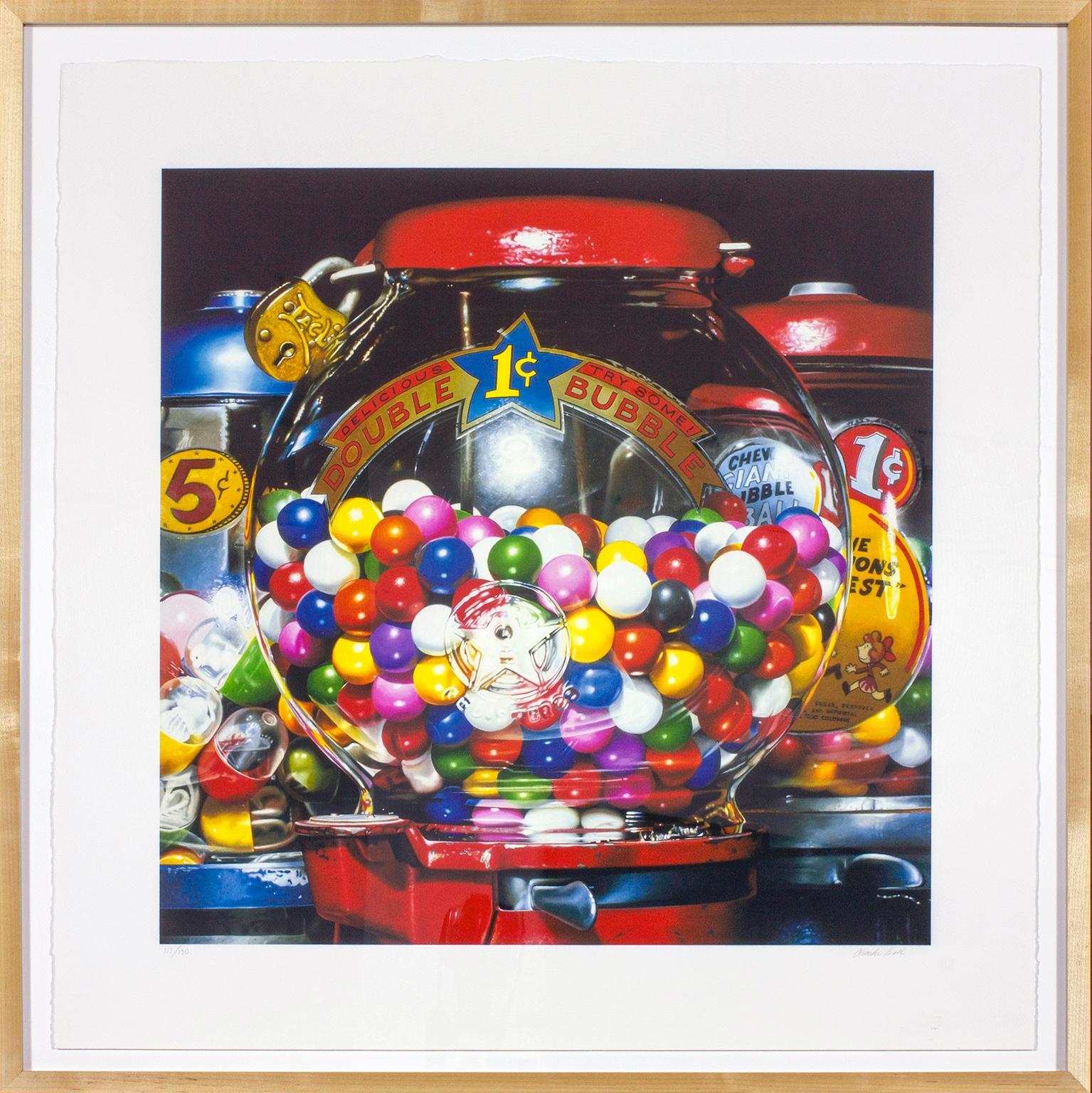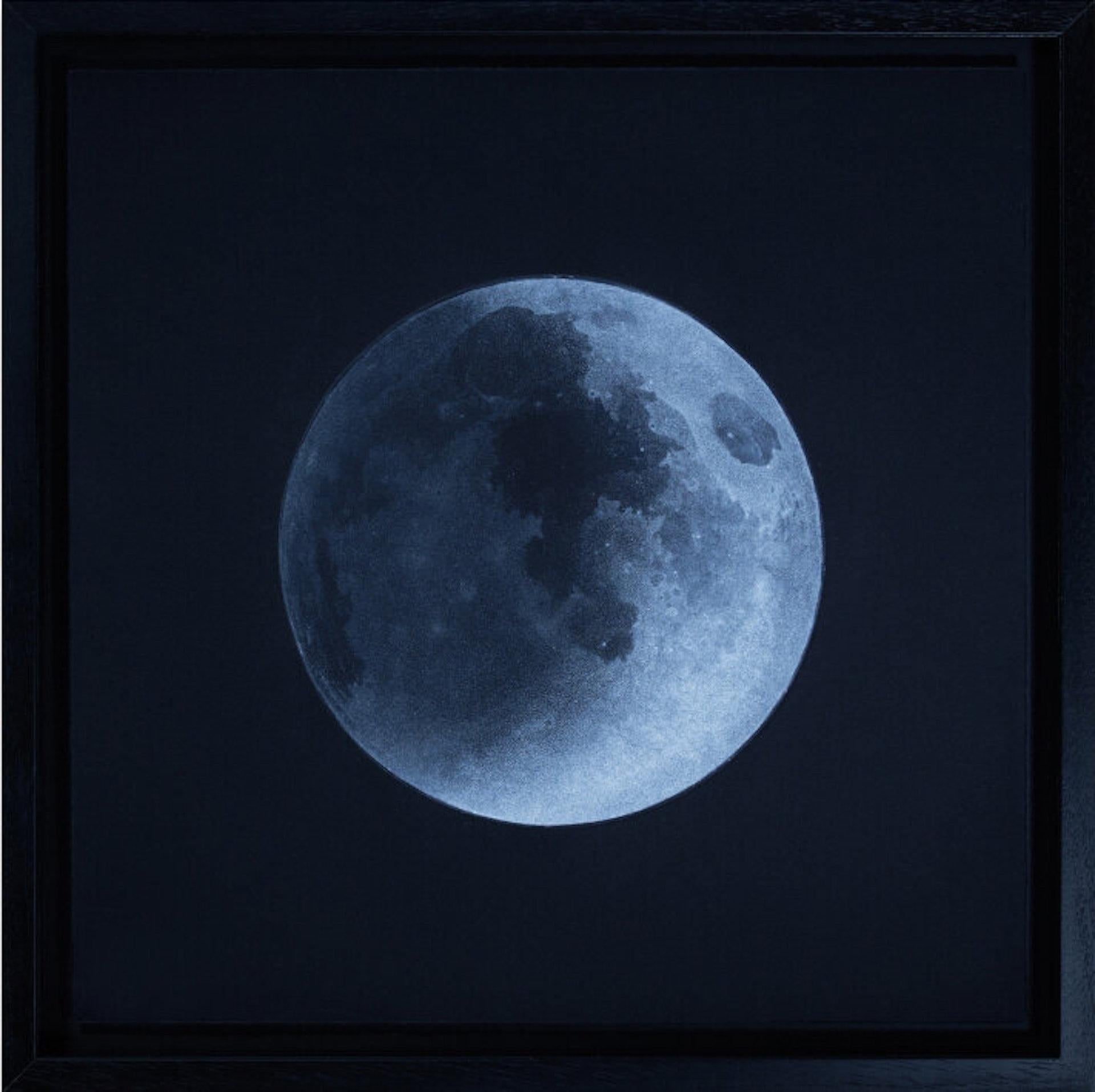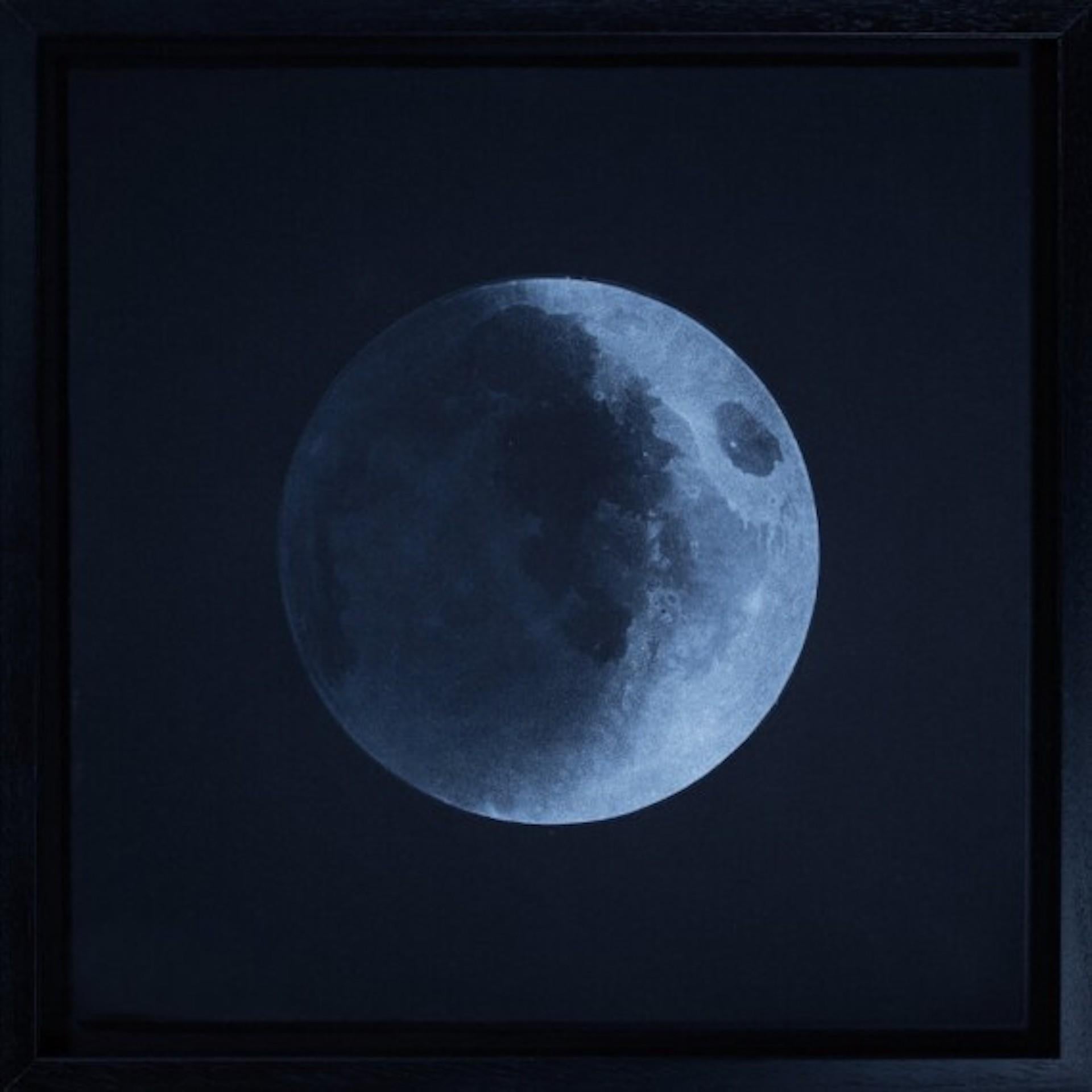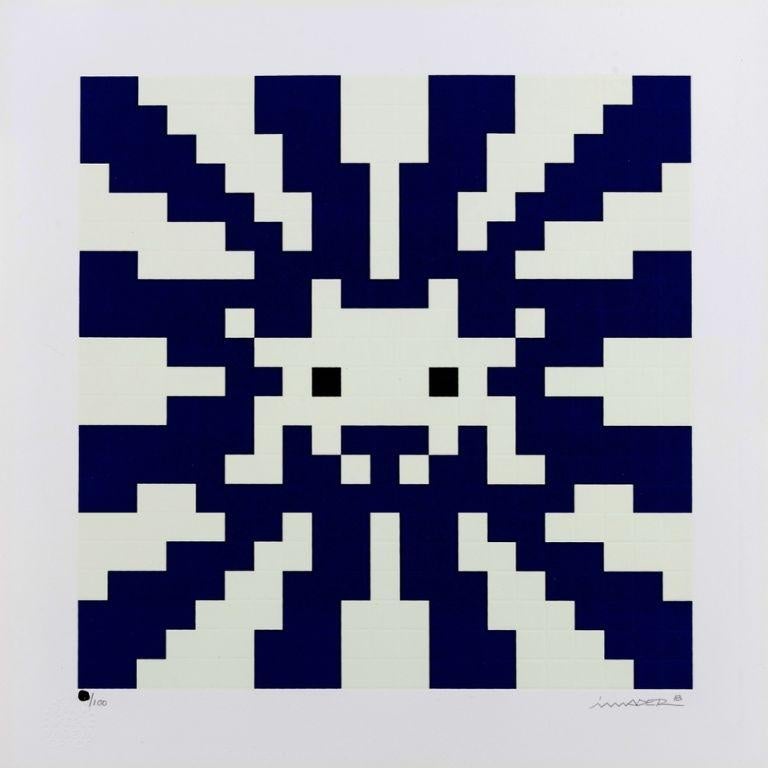Items Similar to Star, from American Signs Portfolio
Want more images or videos?
Request additional images or videos from the seller
1 of 8
Robert CottinghamStar, from American Signs Portfolio2009
2009
About the Item
ROBERT COTTINGHAM
Star, from American Signs portfolio, 2009
screenprint in colors, on wove paper, with full margins,
40 1/8 x 39 1/8 in (101.9 x 99.4 cm)
signed, dated `2009' and numbered edition of 100 in pencil
--
Robert Cottingham
B. 1935, BROOKLYN, NEW YORK
Born in 1935 in Brooklyn, Robert Cottingham is known for his paintings and prints of urban American landscapes, particularly building facades, neon signs, movie marquees, and shop fronts. After serving in the U.S. Army from 1955 through 1958, he earned a BFA at Pratt Institute, Brooklyn, in 1963. Cottingham began his professional artistic career as an art director for the advertising firm Young and Rubicam in the early 1960s. Although he is typically associated with Photorealism, Cottingham never considered himself a Photorealist, but rather a realist painter working in a long tradition of American vernacular scenes. In this respect, his work often draws parallels to a number of American painters such as Stuart Davis, Charles Demuth, Edward Hopper, and Charles Sheeler.
Cottingham’s interest in the intersections of art and commerce derive from his career as an adman and the influence of Pop art. Many of his paintings convey an interest in typography and lettering, as well as an awareness of the psychological impact of certain isolated words and letters. In his facades, techniques from advertising, namely cropping and enlarging, often produce words of enigmatic or comical resonance such as “Art,” “Ha,” or “Oh.” Cottingham’s enlarged sense of scale is reminiscent of James Rosenquist’s work, while his interest in text suggests the influence of Robert Indiana and Jasper Johns. In general, Cottingham viewed his work as continuing the legacy of Pop artists such as Andy Warhol, who also had a background in advertising.
In 1964, Cottingham relocated to Los Angeles for work. There, inspired by the drastically different environment of the West Coast metropolis, he began to commit seriously to painting. Fascinated by Hollywood’s exaggerated glitz and the downtrodden atmosphere of the downtown, Cottingham saw in Los Angeles the relics of a bygone commercial heyday and desired to capture its kitschy and uncanny atmosphere, bathed in the near perpetual sunlight of Southern California.
In 1968, Cottingham ended his advertising career in order to devote all his time to painting. In the late 1960s, he started using photography in his practice, first as an initial reference point for his process. After selecting a photograph, he translates it into black-and-white drawings by projecting the image onto gridded paper, as a means of perfecting the tonal range between light and shadow. He often creates subsequent studies on paper using color. He finalizes the process by projecting either the original slide or any of the drawings onto a canvas and organizing the composition according to a grid. Another reason for Cottingham’s rejection of the Photorealist label is that he does not view his works as mere painterly translations of photographs or reproductions of reality. He has been known to change the words in his facades to alter the meaning of the subject. His primary interest lies in the subject matter—the urban American vernacular—rather than the deployment of a photo-based technique. After spending a period of time in London from 1972 to 1976, Cottingham found the city’s signs and history too foreign and removed from his own interests, and returned to the United States to settle in rural Connecticut. During the late 1970s and 1980s, his urban cityscapes became more expansive, with more complex and broader views of storefronts, vistas, and entire neighborhoods. In the late 1980s and early 1990s, Cottingham expanded his iconography of American vernacular culture to include trains and railroad imagery. More recently, he has focused on images of vintage typewriters, a subject that first interested him in the late 1990s.
Cottingham taught at the Art Center College of Design, Los Angeles (1969–70), and the National Academy of Design, New York (1991). He was the artist in residence at Wesleyan University, Middletown, Connecticut (1987–92). His work has been included in significant group exhibitions, including Documenta, Kassel, West Germany (1972), and those at the Serpentine Gallery, London (1973); Centre national d’art contemporain, Paris (1974); Whitney Museum of American Art, New York (1978); a traveling exhibition at the National Museum of American Art (now Smithsonian American Art Museum), Washington, D.C. (1986); Samsung Museum of Modern Art, Seoul (2001); and Deutsche Guggenheim, Berlin (2009). Cottingham’s printed oeuvre was celebrated by a solo presentation at National Museum of American Art in 1998–99. The artist lives and works in western Connecticut.
- Creator:Robert Cottingham (1935, American)
- Creation Year:2009
- Dimensions:Height: 40 in (101.6 cm)Width: 39 in (99.06 cm)
- Medium:
- Movement & Style:
- Period:
- Condition:Complete portfolio of 12 also available.
- Gallery Location:New York, NY
- Reference Number:1stDibs: LU3261217733
About the Seller
5.0
Vetted Seller
These experienced sellers undergo a comprehensive evaluation by our team of in-house experts.
Established in 1996
1stDibs seller since 2013
654 sales on 1stDibs
Typical response time: 6 hours
- ShippingRetrieving quote...Ships From: New York, NY
- Return PolicyA return for this item may be initiated within 3 days of delivery.
More From This SellerView All
- Art, from American Signs portfolioBy Robert CottinghamLocated in New York, NYROBERT COTTINGHAM Art, from American Signs portfolio, 2009 screenprint in colors, on wove paper, with full margins, 40 1/8 x 39 1/8 in (101.9 x 99.4 cm) signed, dated `2009' and...Category
Early 2000s Photorealist Abstract Prints
MaterialsScreen
- Drinks, from American Signs portfolioBy Robert CottinghamLocated in New York, NYROBERT COTTINGHAM Drinks, from American Signs portfolio, 2009 screenprint in colors, on wove paper, with full margins 40 1/8 x 39 1/8 in (101.9 x 99.4 cm) signed, dated `2009...Category
Early 2000s Photorealist More Prints
MaterialsScreen
- Hi Fi, from American Signs portfolioBy Robert CottinghamLocated in New York, NYROBERT COTTINGHAM HI FI, from American Signs portfolio, 2009 screenprint in colors, on wove paper, with full margins, 40 1/8 x 39 1/8 in (101.9 x 99.4 cm) signed, dated `2009' a...Category
Early 2000s Photorealist More Prints
MaterialsScreen
- American Signs portfolioBy Robert CottinghamLocated in New York, NYROBERT COTTINGHAM American Signs portfolio, 2009 The complete set of twelve screenprints in colors, on wove paper, with full margins, 40 1/8 x 39 1/8 in (101.9 x 99.4 cm) all signed, dated `2009' and numbered edition of 100 in pencil, published by Exhibit A Fine Art and Editions and American Images Atelier, New York, all in excellent condition, contained in original gray silk-covered box with artist and title embossed with gold foil. Robert Cottingham B. 1935, BROOKLYN, NEW YORK Born in 1935 in Brooklyn, Robert Cottingham is known for his paintings and prints of urban American landscapes, particularly building facades, neon signs, movie marquees, and shop fronts. After serving in the U.S. Army from 1955 through 1958, he earned a BFA at Pratt Institute, Brooklyn, in 1963. Cottingham began his professional artistic career as an art director for the advertising firm Young and Rubicam in the early 1960s. Although he is typically associated with Photorealism, Cottingham never considered himself a Photorealist, but rather a realist painter working in a long tradition of American vernacular scenes. In this respect, his work often draws parallels to a number of American painters such as Stuart Davis, Charles Demuth, Edward Hopper, and Charles Sheeler. Cottingham’s interest in the intersections of art and commerce derive from his career as an adman and the influence of Pop art. Many of his paintings convey an interest in typography and lettering, as well as an awareness of the psychological impact of certain isolated words and letters. In his facades, techniques from advertising, namely cropping and enlarging, often produce words of enigmatic or comical resonance such as “Art,” “Ha,” or “Oh.” Cottingham’s enlarged sense of scale is reminiscent of James Rosenquist’s work, while his interest in text suggests the influence of Robert Indiana and Jasper Johns. In general, Cottingham viewed his work as continuing the legacy of Pop artists such as Andy Warhol, who also had a background in advertising. In 1964, Cottingham relocated to Los Angeles for work. There, inspired by the drastically different environment of the West Coast metropolis, he began to commit seriously to painting. Fascinated by Hollywood’s exaggerated glitz and the downtrodden atmosphere of the downtown, Cottingham saw in Los Angeles the relics of a bygone commercial heyday and desired to capture its kitschy and uncanny atmosphere, bathed in the near perpetual sunlight of Southern California. In 1968, Cottingham ended his advertising career in order to devote all his time to painting. In the late 1960s, he started using photography in his practice, first as an initial reference point for his process. After selecting a photograph, he translates it into black-and-white drawings by projecting the image onto gridded paper...Category
Early 2000s American Realist Still-life Prints
MaterialsScreen
- La Blusa Rosa IIBy Julian SchnabelLocated in New York, NYLa Blusa Rosa II, 1995 "Sexual Spring-like Winter" is a large painterly work, created with layers of pink and resin by the art and film world's favorite enfant terrible, Julian Schn...Category
1990s Neo-Expressionist Abstract Prints
MaterialsScreen
- Hi, from American Signs PortfolioBy Robert CottinghamLocated in New York, NYROBERT COTTINGHAM Hi, from American Signs portfolio, 2009 screenprint in colors, on wove paper, with full margins 40 1/8 x 39 1/8 in (101.9 x 99.4 cm) signed, dated `2009' an...Category
Early 2000s Pop Art More Prints
MaterialsScreen
You May Also Like
- "Double Bubble" silkscreen by Photorealist painter Charles Bell Edition of 150By Charles BellLocated in Boca Raton, FL"Double Bubble" silkscreen of gumball machine by Photorealist painter Charles Bell. Hand-numbered 117/150 in pencil in front lower left corner. Hand-signed Charles Bell in pencil in ...Category
1990s Photorealist Still-life Prints
MaterialsScreen
- Waxing Crescent (The Moon Series), Guy Allen, Limited Edition Print, AffordableBy Guy AllenLocated in Deddington, GBWaxing Crescent (The Moon Series) by Guy Allen [2020] limited_edition Etching on paper Edition number 75 Image size: H:51 cm x W:51 cm Complete Size of Unframed Work: H:51 cm x W...Category
21st Century and Contemporary Photorealist Still-life Prints
MaterialsEtching, Paper
- Waxing Crescent Young (The Moon Series), Guy Allen, Limited Edition PrintBy Guy AllenLocated in Deddington, GBWaxing Crescent Young (The Moon Series) by Guy Allen [2020] limited_edition Etching on paper Edition number 75 Image size: H:51 cm x W:51 cm Complete Size of Unframed Work: H:51 ...Category
21st Century and Contemporary Photorealist More Prints
MaterialsPaper, Etching
- Zhiyong Jing Silkscreen Print "Come to You #2" Edition of 50 Cristo Rey JesusBy Zhiyong JingLocated in Draper, UT"Come to You no. 2" Edition of only 50 prints. Signed and Numbered by the artist in pencil 13/100. Born in 1982, Jing Zhiyong's creative work was predominantly inspired by the 1990s. A collective of artists working in the United Kingdom, who came to be known as the YBAs, or Young British Artists, defined the artistic culture of the 1990s. Affiliated loosely by their age and nationality, they were a varied collective of practitioners. A number of the YBAs attended the Royal College of Art and Goldsmiths in London, and were favoured by the ‘super collector’ of the time, Charles Saatchi. The most renowned member of the group is Damien Hirst, and other members included Chris Ofili, Tracey Emin, Marc Quinn, Gavin Turk, Sarah Lucas...Category
2010s Contemporary Still-life Prints
MaterialsScreen
- Wrapped Papaya Fruit Risograph PrintLocated in Collingwood, VictoriaIn this series entitled 'Freshly Wrapped', Alice explores the relationship between fresh produce and plastic. For the city-dweller, plastic wrapping has become as much a part of the way we eat fruit and vegetables as the skin of the thing itself. Instead of pulling from the soil or plucking from a tree; we squeeze our produce from mesh bags...Category
2010s Contemporary Still-life Prints
MaterialsScreen
- Sunset ( Glow In The Dark )By InvaderLocated in Miami, FLInvader Sunset ( Glow In The Dark ) , 2018 Hand-signed and numbered by artist Screenprint in colours with phosphorescent ink and embossing 16 3/10 × 16 3/10 in Edition of 100Category
2010s Street Art More Prints
MaterialsScreen





